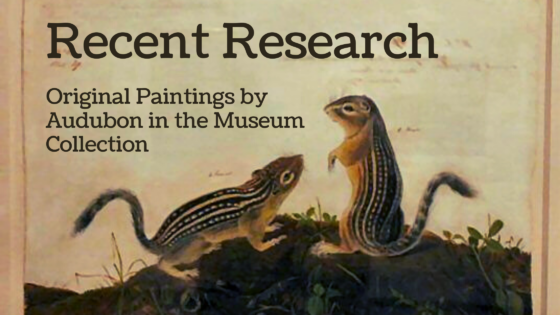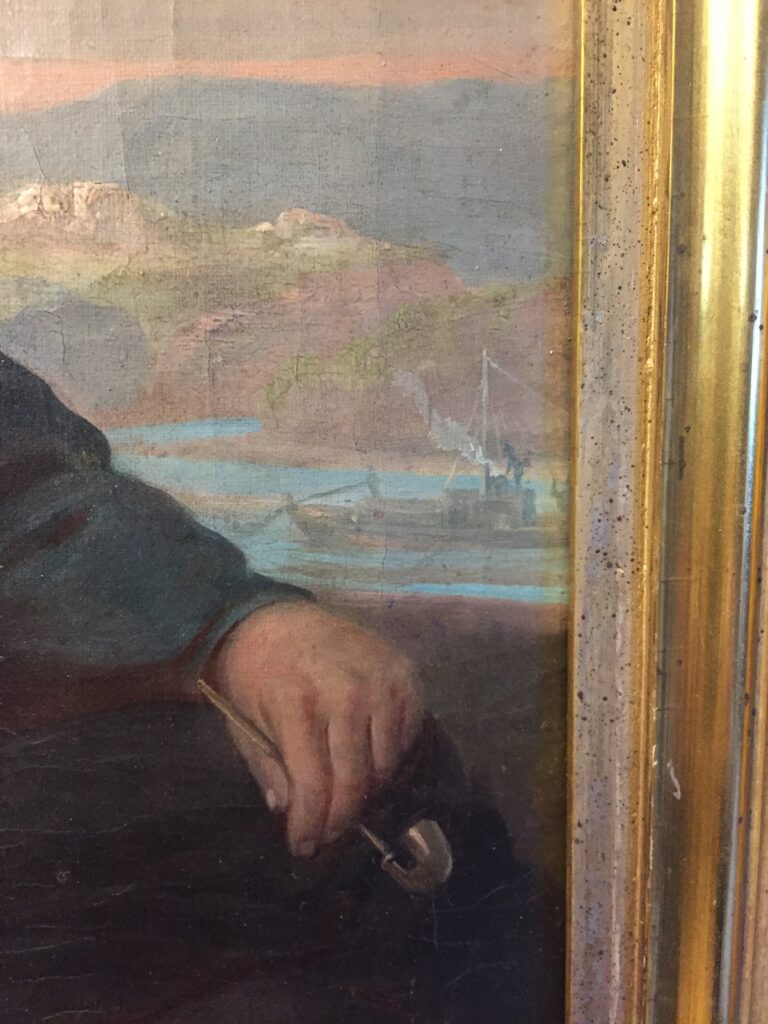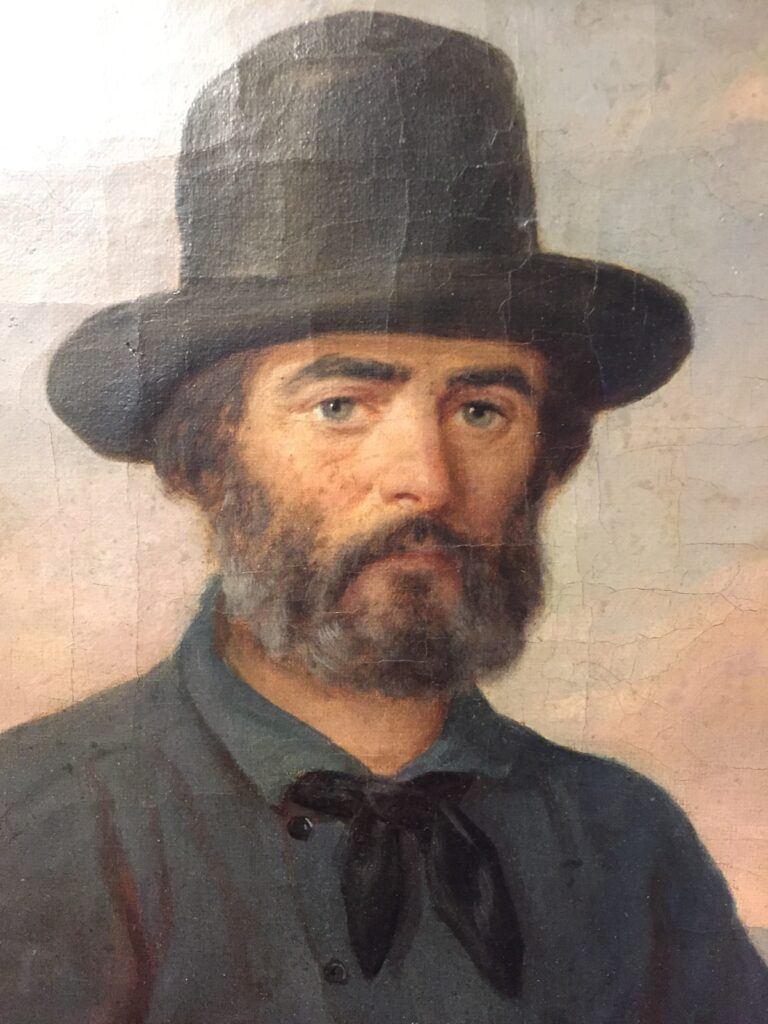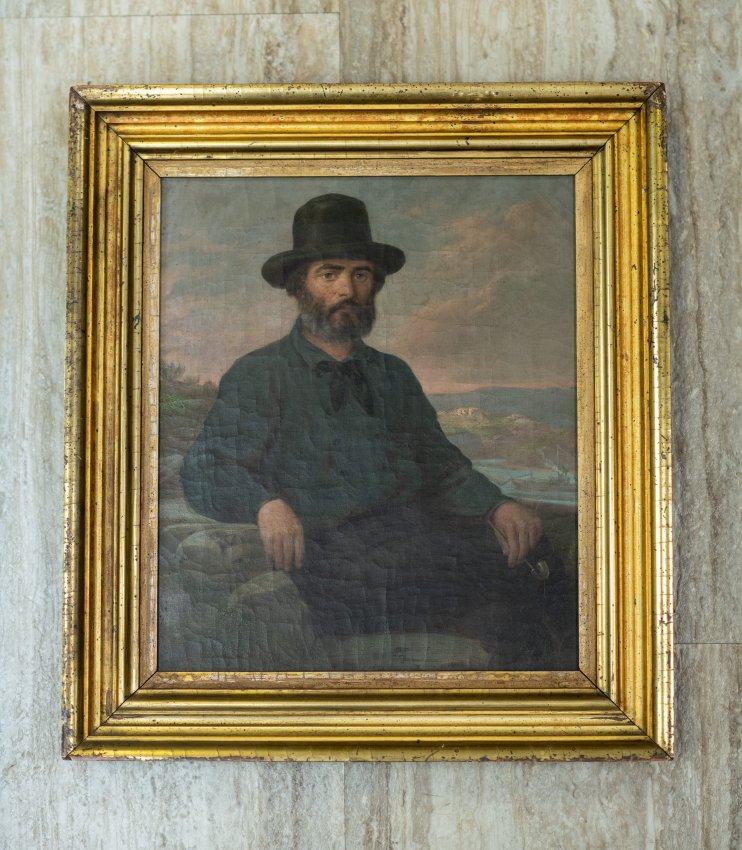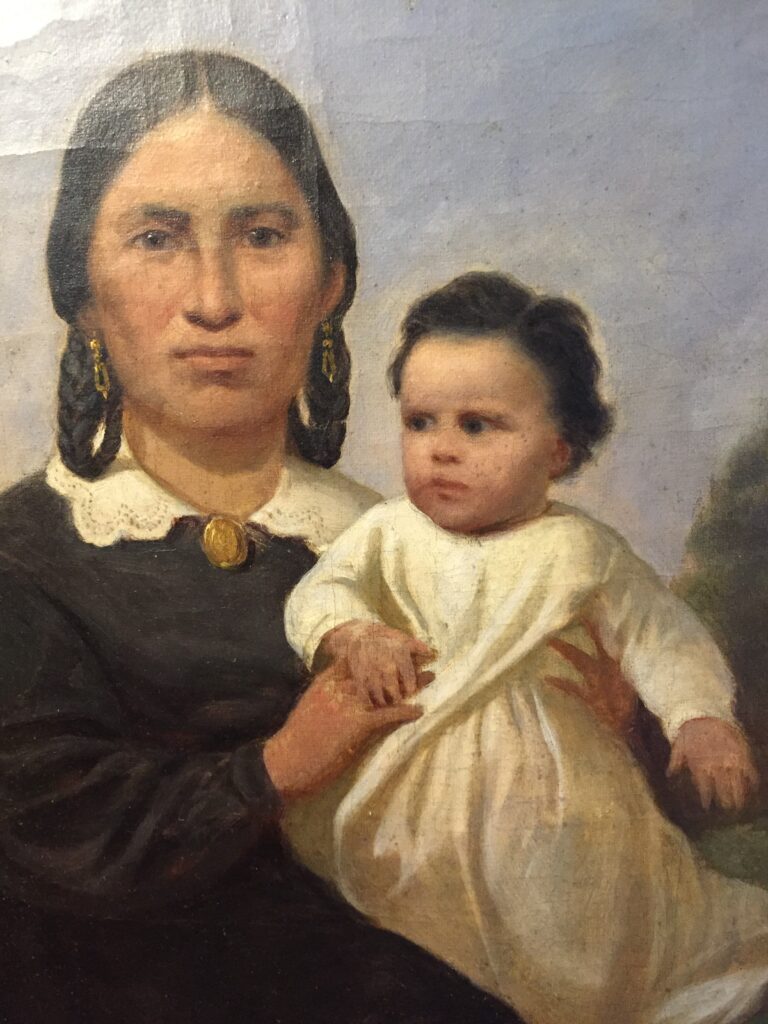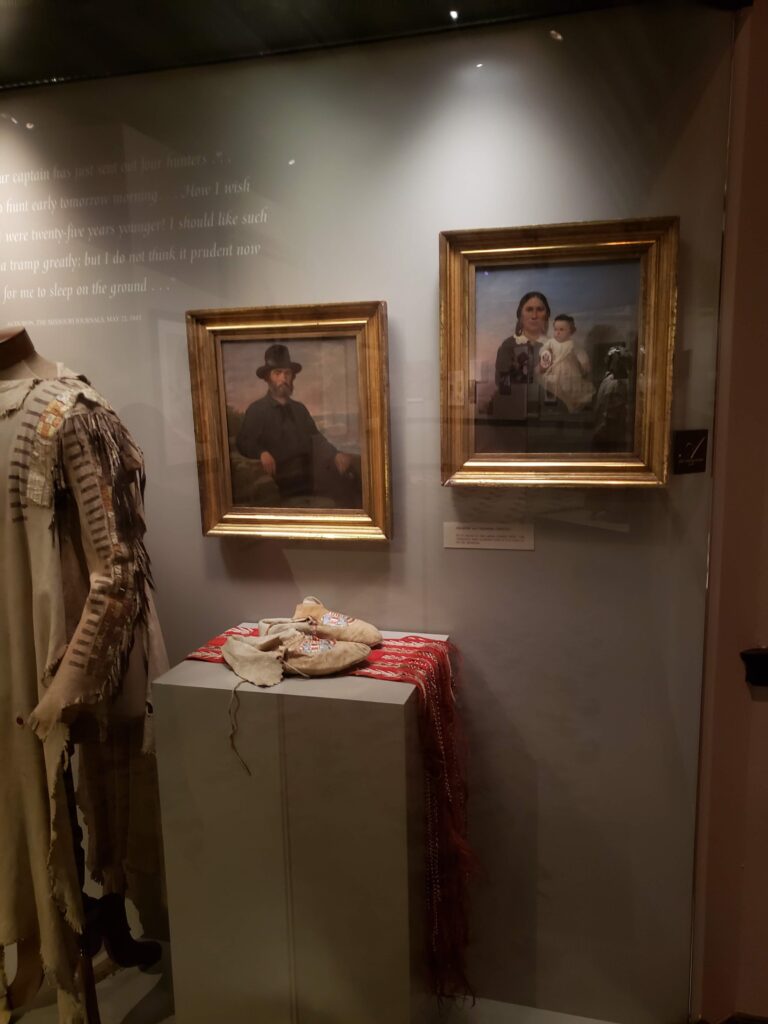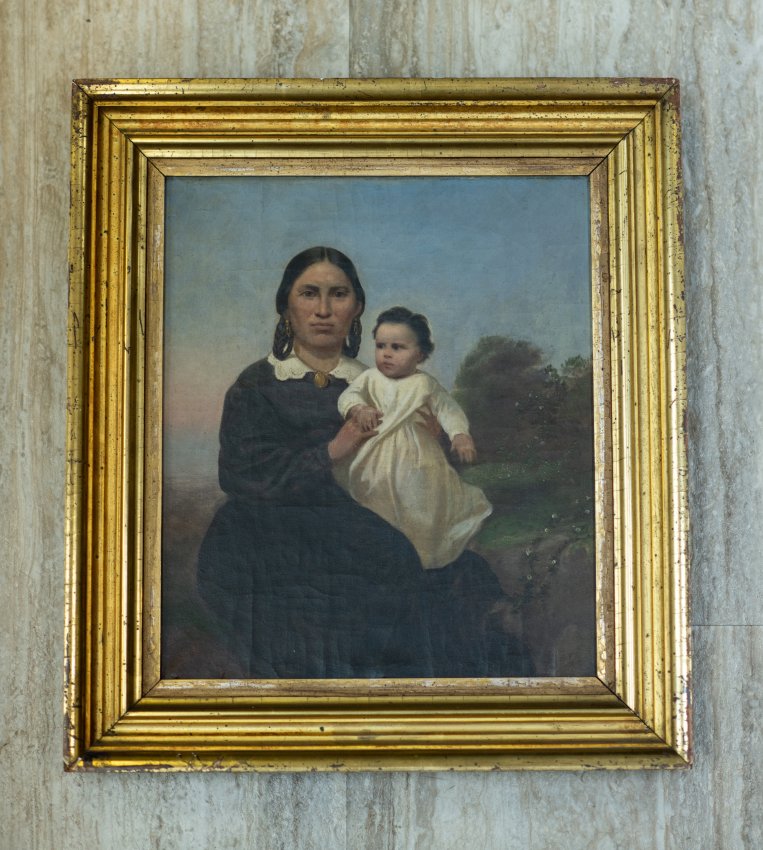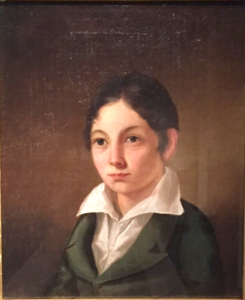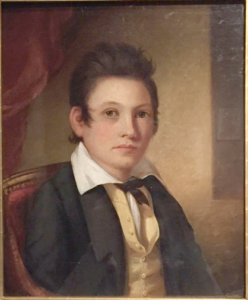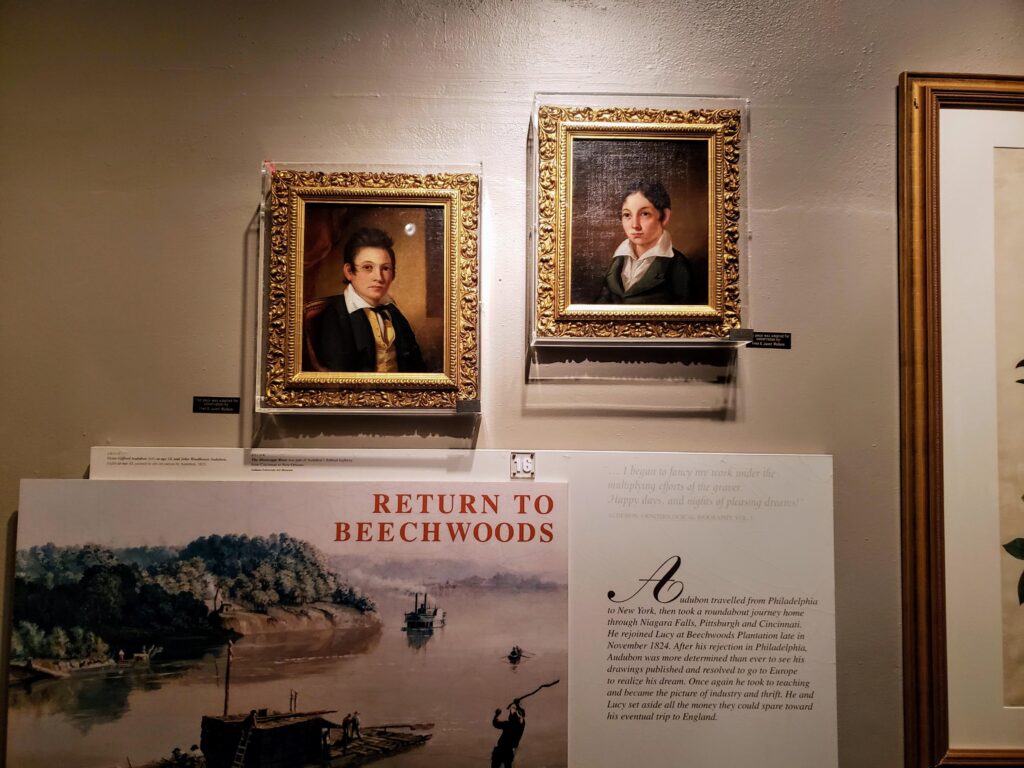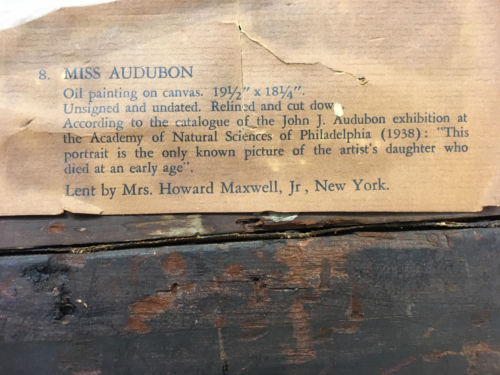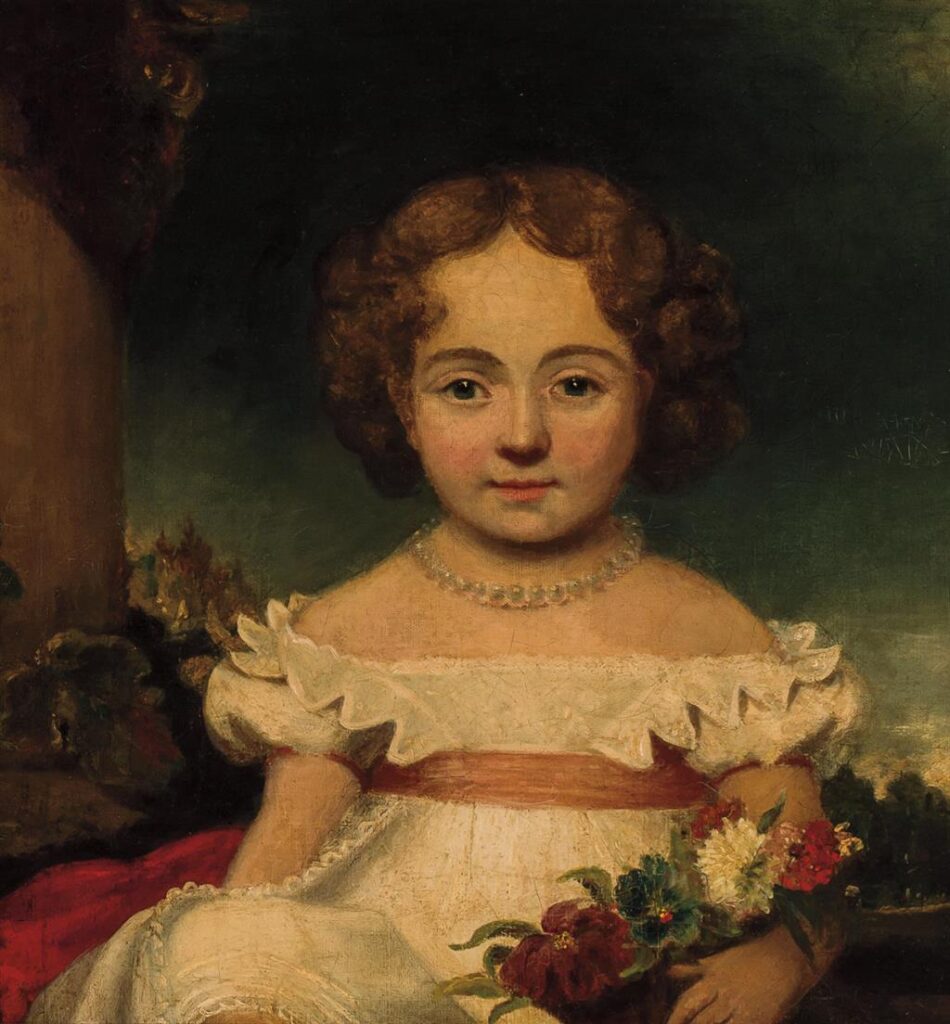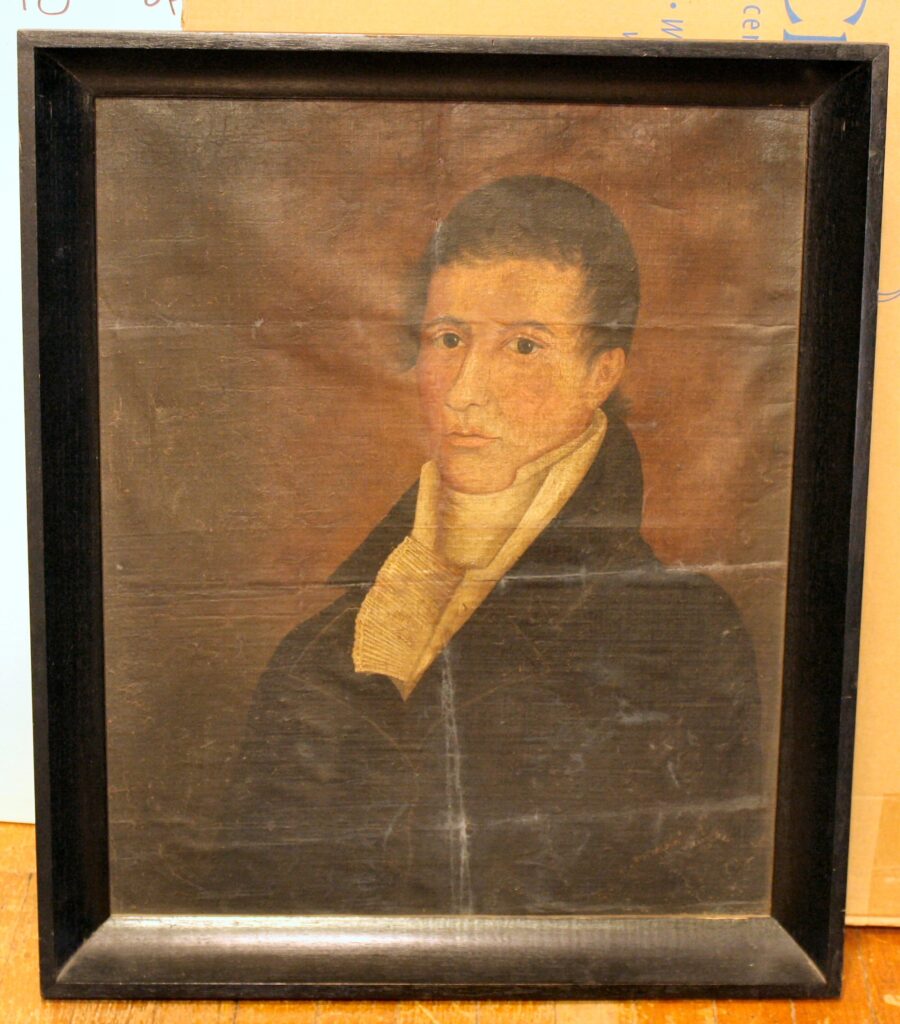In our Recent Research series, curator Heidi Taylor-Caudill shares answers to questions sent to the Audubon Museum about John James Audubon and his family, the museum’s collection, and the history of John James Audubon State Park.
A visitor to the museum recently asked us how many original paintings by John James Audubon (1785-1851) are in our collection. Currently there are 21 original paintings in our holdings that we attribute to John James Audubon. 10 works are on display in the galleries and 11 works are resting in storage. One of these paintings is on loan to the museum from the Friends of Audubon State Park.
Interested in learning more about these paintings? Check out the list below for images and details. You can also feel free to contact me with questions at 502-782-9716 or heidi.taylorcaudill@ky.gov.
Works On Display
As of the publication of this post, the paintings below are on display in the Audubon Museum galleries.

John James Audubon
Mink, circa 1845
Oil, watercolor, ink
L.S. Tyler Collection, JJA.1938.1298
Current Location: Gallery A
This unfinished painting on paper shows two minks on a bank overlooking a river and waterfall. One of the minks is standing on a dead tree limb in profile facing to the left. The other mink is standing on the ground facing to the right with its mouth open and teeth barred. In the background is a waterfall and river and a log building structure, possibly a mill. A forest of leafy trees sits beyond the water.
The Tyler Collection was purchased in 1994 through numerous donations made to the Friends of Audubon State Park, as well as contributions from the Preston Foundation and the Kentucky Department of Parks.
John James Audubon (attributed to)
Alexander Culbertson, circa 1843
Oil on canvas
The Culbertson Collection, JJA.1995.4
Current Location: Gallery A
This is a portrait of Alexander Culbertson attributed to John James Audubon, but also possibly created by John Mix Stanley. Culbertson was an agent with the American Fur Company stationed at Fort Union, Montana. This painting is believed to be one of Audubon’s last oil portraits. Audubon began to lose his eyesight shortly thereafter and could no longer paint.
The portrait shows Culbertson sitting with his legs crossed on some rocks in a semi-profile position. His face is mostly turned toward the viewer. He has blue-gray eyes, graying hair, and a beard. Culbertson wears a black brimmed hat, a double breasted dark blue-green shirt with a black scarf necktie, and black pants. He holds a pipe in his left hand. A hilly, forested area and a river (possibly the Missouri River) are seen in the background. There is a cargo vessel painted on the river (possibly a flat boat) with what appears to be a couple of people on board.
Purchased by the Friends of Audubon State Park in 1995.
John James Audubon (attributed to)
Mrs. Alexander Culbertson (Natawista), circa 1843
Oil on canvas
The Culbertson Collection, JJA.1995.5
Current Location: Gallery A
Available for Adoption
This is a portrait of Natawista Iksana, a Kainah interpreter and diplomat. She was married to Alexander Culbertson. It is attributed to John James Audubon, but was also possibly created by John Mix Stanley. The painting is believed to be one of Audubon’s last oil portraits. Audubon began to lose his eyesight shortly thereafter and could no longer paint.
In this portrait, Natawista wears a black dress with a white lace collar, gold earrings, and a gold brooch at her throat. She is shown seated in an outdoor setting, facing the viewer, and holding a young child dressed in a white gown. Natawista’s hair is black, parted at the middle with the sides in low braids pinned up. The background shows a wooded area to the viewer’s right and a far-off distance to the left as though Natawista is seated at an overlook.
Purchased by the Friends of Audubon State Park in 1995.
John James Audubon
Victor Gifford Audubon, circa 1823
Oil on canvas
L.S. Tyler Collection, JJA.1941.84
Current Location: Gallery B
Adopted by Fred and Janet Wallace
John James Audubon
John Woodhouse Audubon, circa 1823
Oil on canvas
L.S. Tyler Collection, JJA.1941.85
Current Location: Gallery B
Adopted by Fred and Janet Wallace
These portraits of John James Audubon and Lucy Audubon’s sons, Victor Gifford and John Woodhouse, are some of the first known oil paintings by Audubon. He created them shortly after he began working with artist John Steen, who taught him the use of oils. In the portraits, Victor Gifford is shown at age 14 while John Woodhouse is shown at age 11. Both works are unsigned and undated.
The portrait of Victor Gifford was formerly owned by Florence Audubon, the daughter of John Woodhouse and granddaughter of John James Audubon. John Woodhouse’s portrait passed down through the family to Leonard Sanford Tyler, his great-nephew.
The Tyler Collection was purchased in 1994 through numerous donations made to the Friends of Audubon State Park, as well as contributions from the Preston Foundation and the Kentucky Department of Parks.
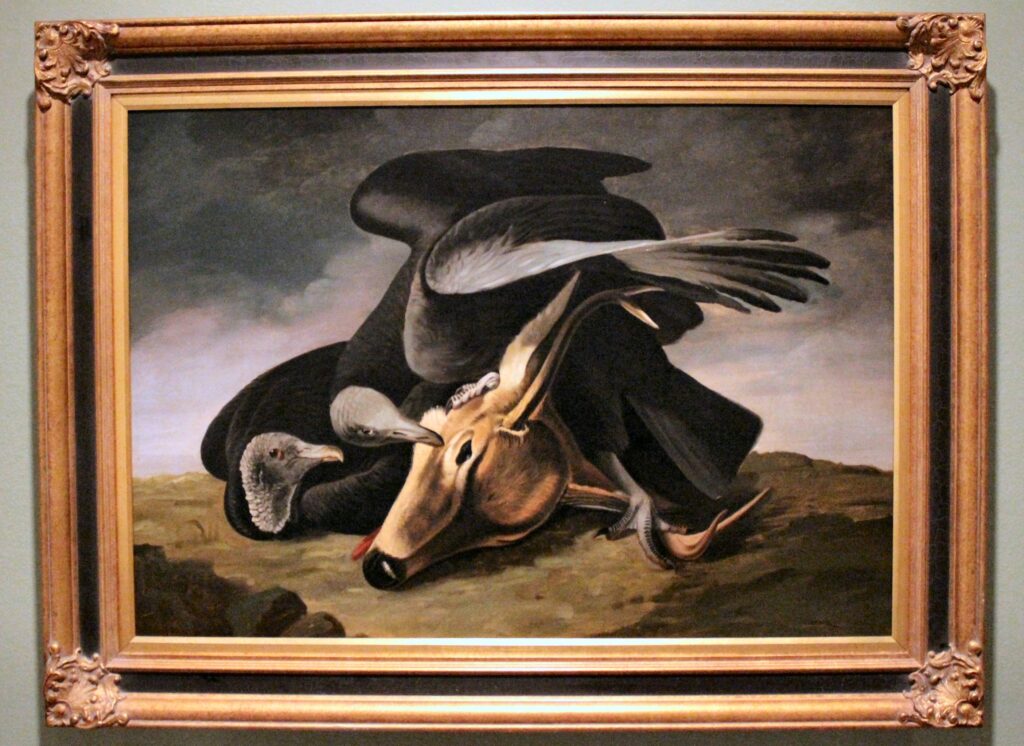
John James Audubon
The Vultures, 1829
Oil on canvas
L.S. Tyler Collection, JJA.1938.1338
Current Location: Gallery C
This is an original oil painting by John James Audubon of two black vultures feeding on the head of a white-tailed deer. According to our records, Audubon created this picture in Beech Grove, Louisiana in December 1829.
The Tyler Collection was purchased in 1994 through numerous donations made to the Friends of Audubon State Park, as well as contributions from the Preston Foundation and the Kentucky Department of Parks.

John James Audubon
American Bald Eagle, 1828
Oil on canvas
L.S. Tyler Collection, JJA.1938.1340
Current Location: Gallery C
This is an original oil painting by John James Audubon of an American bald eagle sitting on a cliff ledge. This is one of the paintings done by Audubon to raise money for living expenses and to finance the engraving of his work for The Birds of America. According to our records, Audubon created this painting in February 1828.
The Tyler Collection was purchased in 1994 through numerous donations made to the Friends of Audubon State Park, as well as contributions from the Preston Foundation and the Kentucky Department of Parks.

John James Audubon
Red Thrush or Brown Thrasher, 1815
Watercolor, graphite, pastel
John James Audubon Museum Collection, JJA.1996.1
Current Location: Gallery A
This is an original drawing by John James Audubon in watercolor, pastel, and graphite pencil. The image shows a single brown thrasher on a lichen covered branch with Greenbrier vine. The bird is located near the top of composition angled downward from upper left to lower right. There is great detail in the branch, vine, and head of the bird, but less detail in the bird’s body. There are some touches of gum arabic on upper surfaces of leaves. The drawing is signed by Audubon with his initials and dated April 24, 1815.
Purchased by the Friends of Audubon State Park and the Preston Family Foundation in 1996.
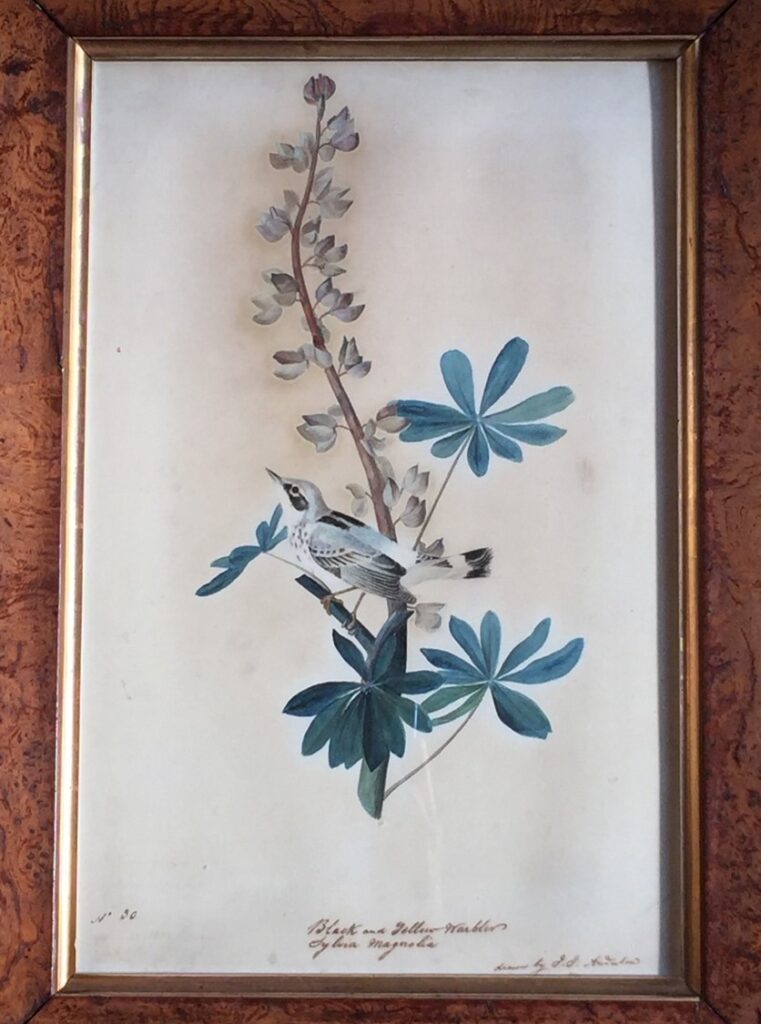
John James Audubon
Magnolia Warbler, 1809
Watercolor, graphite, pastel
John James Audubon Museum Collection, JJA.1996.2
Current Location: Gallery A
This is an original drawing of a Magnolia Warbler by John James Audubon. The drawing features a single warbler near the center of the composition angled upward from lower right to upper left.
Purchased by the Friends of Audubon State Park and the Preston Family Foundation in 1996.
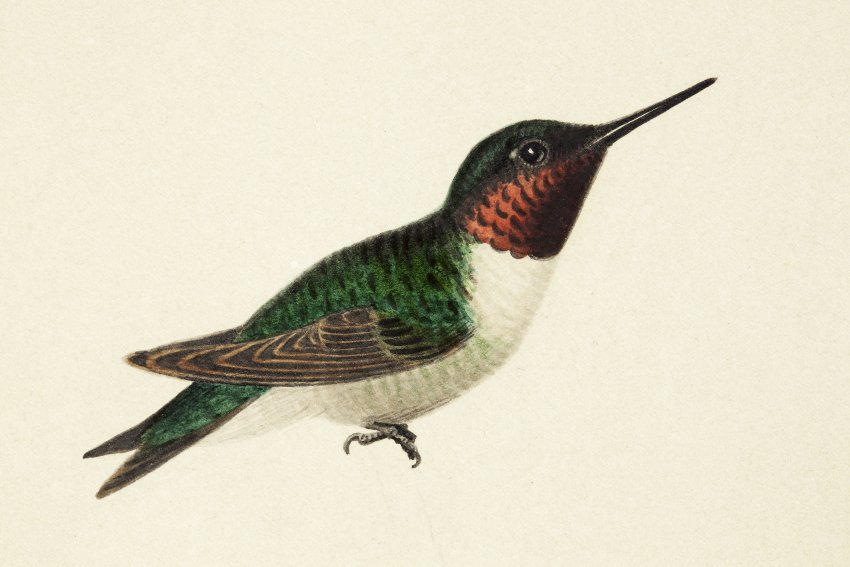
John James Audubon
Ruby-throated Hummingbird, 1821
Watercolor, pastel, India ink, graphite
L.S. Tyler Collection, JJA.1938.560
Current Location: Gallery B
Adopted by Joan Williams
This is an unfinished watercolor study of the Ruby-throated Hummingbird by John James Audubon. The painting shows a male hummingbird sitting on a small penciled-in branch. Audubon used a magnifying glass to capture the minute details of the hummingbird’s feathers and features.
Upon Audubon’s death in 1851, this small study became the property of his wife, Lucy Audubon. It was passed down through Victor Gifford’s descendants, eventually coming to Leonard Sanford Tyler (Audubon’s great-great grandson).
The Tyler Collection was purchased in 1994 through numerous donations made to the Friends of Audubon State Park, as well as contributions from the Preston Foundation and the Kentucky Department of Parks.
Works in Storage
As of the publication of this post, the paintings below are not on display in the Audubon Museum galleries, but resting in storage.
John James Audubon (attributed to)
Miss Audubon, circa 1820
Oil on canvas
Friends of Audubon State Park Collection, JJA.L.2016.1.1
Current Location: Storage
Adopted by Wilma and Perry D. Potter in honor of their grandchildren, Micheal and Jessica
This is a post-mortem painting of a little girl believed to be Lucy Audubon, John James and Lucy Audubon’s first daughter who died at the age of two in Henderson, Kentucky, during the winter of 1817. The Audubons buried Lucy in their garden. She was later moved to Hopkins Cemetery in Henderson. Her body is located in an unmarked grave.
The painting is attributed to John James Audubon. It shows a small girl wearing a white, off-the-shoulder dress, red sash, and pearl necklace. She holds white, blue, and pink flowers in her left arm. The girl has curly light brown (perhaps auburn) hair and blue eyes. Shown in the background to the left is a tall column, perhaps a tree with autumnal-colored foliage, set against a dark gray sky. In the lower right corner there appears to be a tree-lined road with a human figure. The painting is protected in a wood frame with gold gild and decorative floral elements, including acanthus leaves. A paper label that accompanies the painting reads: “This portrait is the only known picture of the artist’s daughter who died at an early age.”
Purchased by the Friends of Audubon State Park in 2016. Currently on loan to the Audubon Museum.
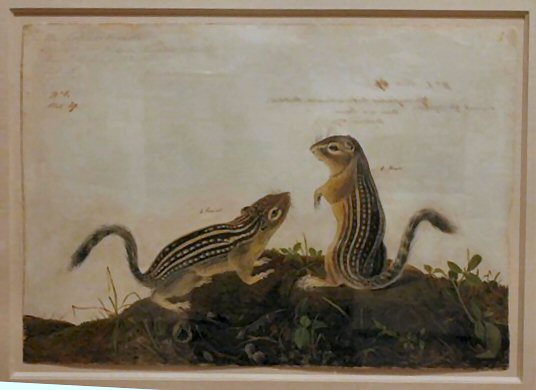
John James Audubon
Leopard Spermophile, 1841
Watercolor
Susan Starling Towles Collection, JJA.1938.140
Current Location: Storage
This is a watercolor painting of the thirteen-lined ground squirrel, formerly known as the leopard spermophile. John James Audubon produced the piece as a proof for the Imperial Folio edition of the Viviparous Quadrupeds of North America. The image shows two marmots or ground squirrels, 1 female and 1 male, positioned facing each other on a dirt knoll with some vegetation. Handwritten on the upper left corner (viewer’s left) are the words, “The Leopard-Marmots / Spermophilus tridecem – lineatus, Mitchell / New York June 13th 1841 / J.J.A. / No. 8 / Plate 39.” Field notes are written on the back of the painting.
Gift of Susan Starling Towles, 1938.
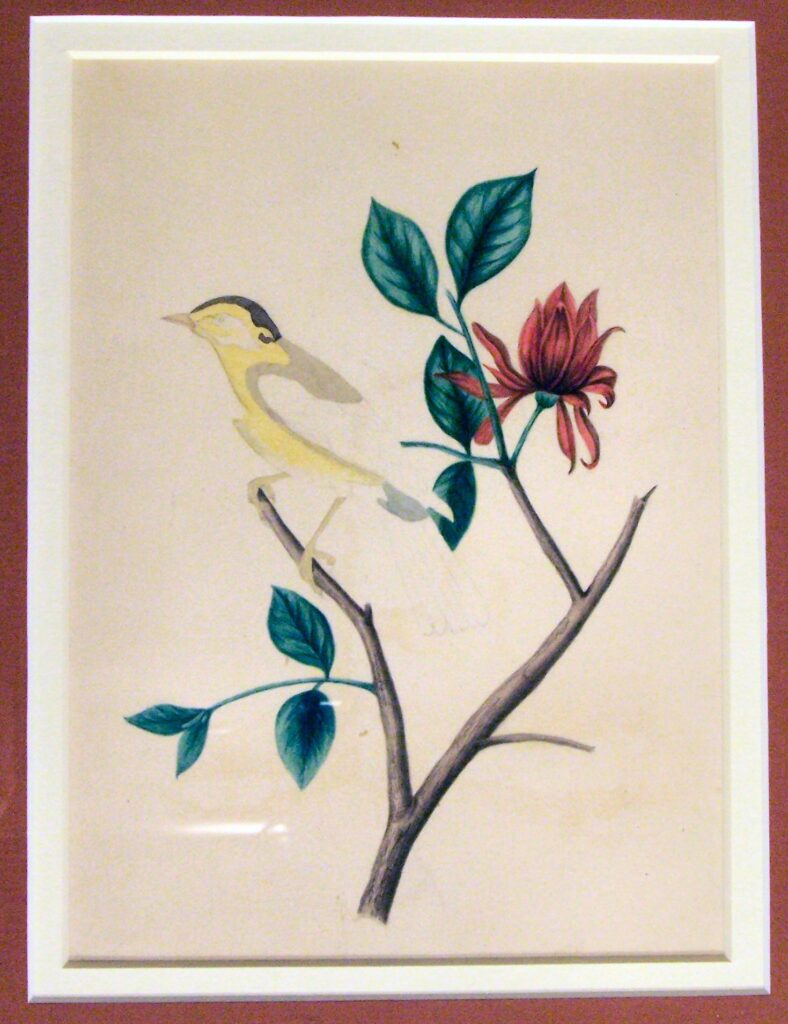
John James Audubon
Wood Warbler, circa 1839-1844
Watercolor
L.S. Tyler Collection, JJA.1938.557
Current Location: Storage
This unfinished, original painting may have been a colorist’s model used in the hand-coloring process. The image shows the undercoats with the wings undone and no detail in the face of the bird. It is in the octavo size.
The Tyler Collection was purchased in 1994 through numerous donations made to the Friends of Audubon State Park, as well as contributions from the Preston Foundation and the Kentucky Department of Parks.
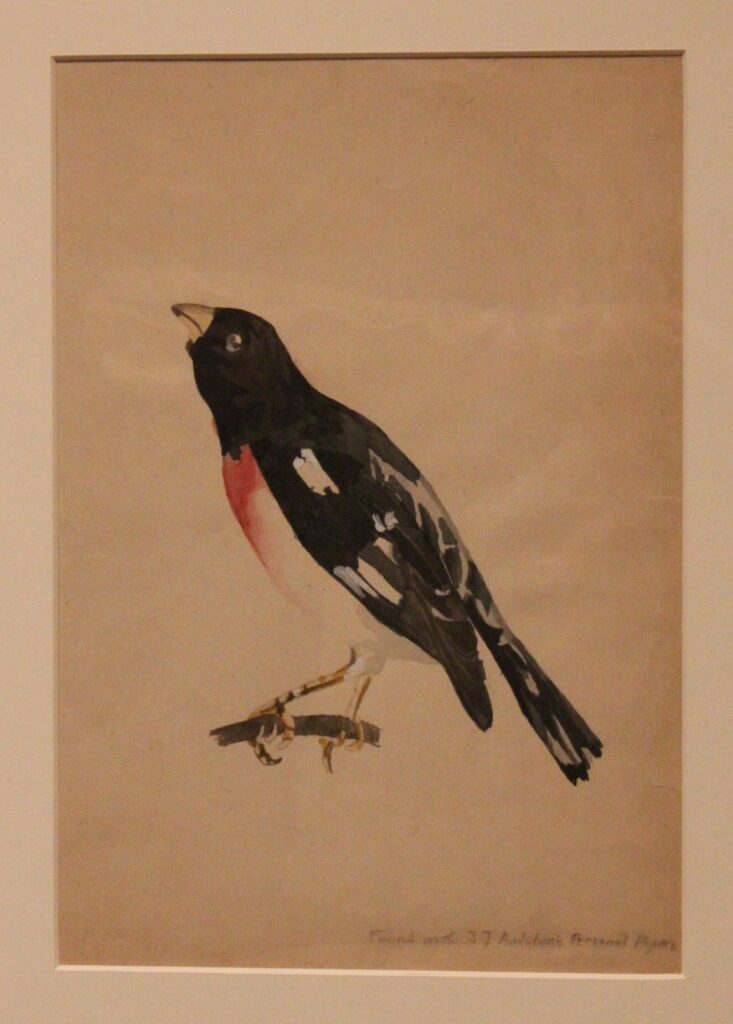
John James Audubon
Rose-breasted Grosbeak, circa 1837
Watercolor
L.S. Tyler Collection, JJA.1938.559
Current Location: Storage
This unfinished painting shows a single bird facing to the left with its feet grasping a small section of branch. The bird has a white breast flushed with reddish-pink colors. Feathers are black with washes of white paint. There is printing in pencil along the bottom right edge that reads, “Found with J.J. Audubon’s Personal Papers.”
The Tyler Collection was purchased in 1994 through numerous donations made to the Friends of Audubon State Park, as well as contributions from the Preston Foundation and the Kentucky Department of Parks.
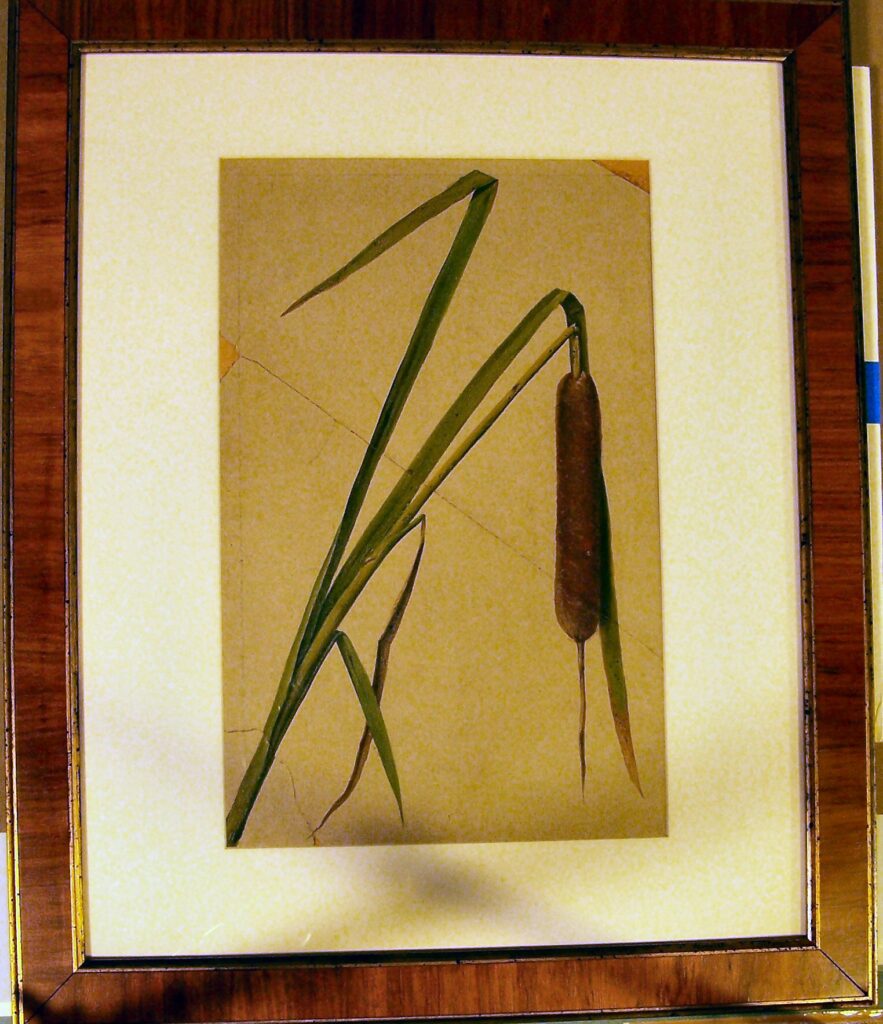
John James Audubon
Cattails (Cat of Nine Tails), circa 1820
Watercolor
L.S. Tyler Collection, JJA.1938.1300
Current Location: Storage
This watercolor painting shows a seed head of a cattail hanging from its stem with a leaf balancing in its direction. The image was used as the background for plate 214, Red-and-white-shouldered Marsh-Blackbird, in the first Octavo edition of The Birds of America.
The Tyler Collection was purchased in 1994 through numerous donations made to the Friends of Audubon State Park, as well as contributions from the Preston Foundation and the Kentucky Department of Parks.
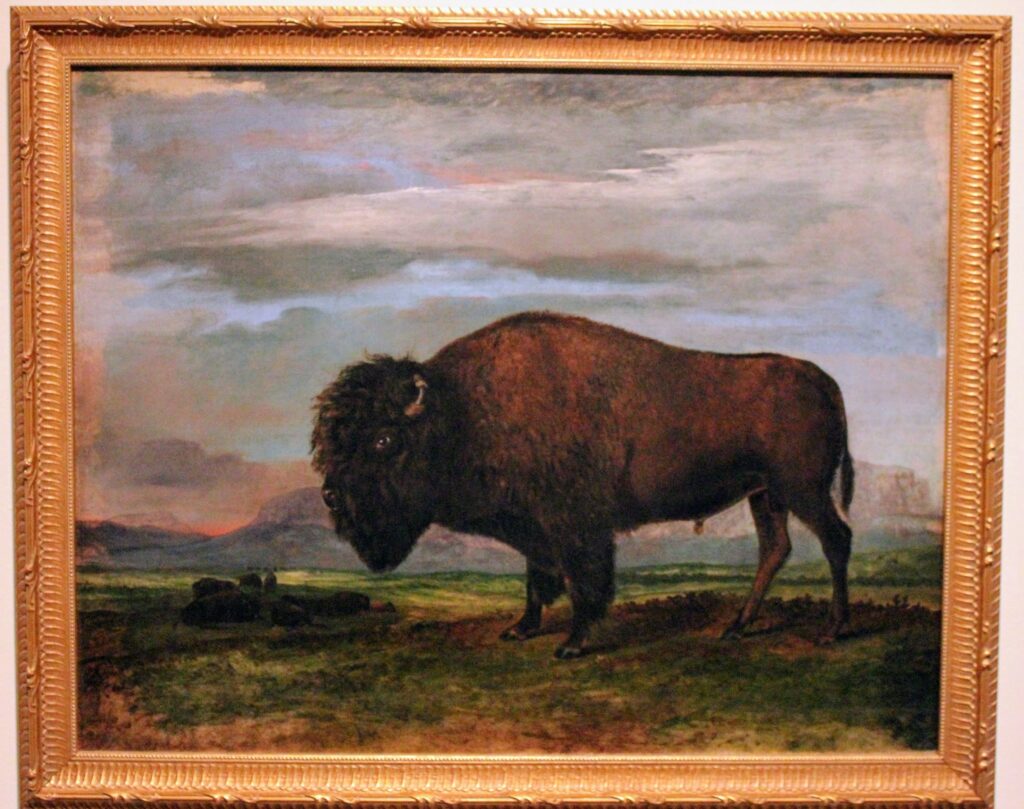
John James Audubon or John Woodhouse Audubon
American Bison or Buffalo, circa 1845
Oil on canvas
L.S. Tyler Collection, JJA.1938.1328
Current Location: Storage
This is an unfinished oil painting of a bison bull or buffalo attributed to John James Audubon or his son, John Woodhouse Audubon. The painting was made for The Viviparous Quadrupeds of North America. According to Audubon family lore, John James Audubon painted the bison in 1843 based on a bull he killed in Montana. The painting appears to have been re-worked by John Woodhouse Audubon, probably around 1862.
The image shows a large male bison in the foreground and a herd of bison on the left in the middle and background. They are situated on a prairie with mountains and a setting sun in a dark cloudy sky in the background.
The Tyler Collection was purchased in 1994 through numerous donations made to the Friends of Audubon State Park, as well as contributions from the Preston Foundation and the Kentucky Department of Parks.
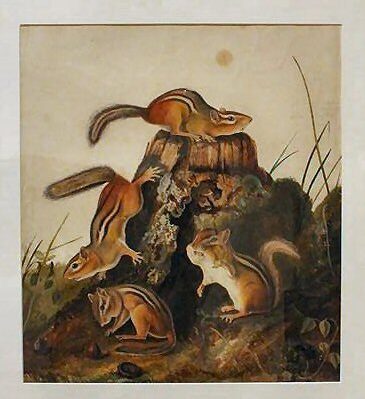
John James Audubon
Chipping Squirrel, Hackee, circa 1841
Oil, watercolor
L.S. Tyler Collection, JJA.1938.1365
Current Location: Storage
This is an original watercolor and oil painting on paper done for The Viviparous Quadrupeds of North America. The image shows four chipmunks situated around a tree stump. One chipmunk is sitting on top of the stump, one is on the side of it, and two are on the ground with open acorn shells. One of the chipmunks has stuffed cheeks. There is a faint inscription written in pencil along upper right side.
The Tyler Collection was purchased in 1994 through numerous donations made to the Friends of Audubon State Park, as well as contributions from the Preston Foundation and the Kentucky Department of Parks.
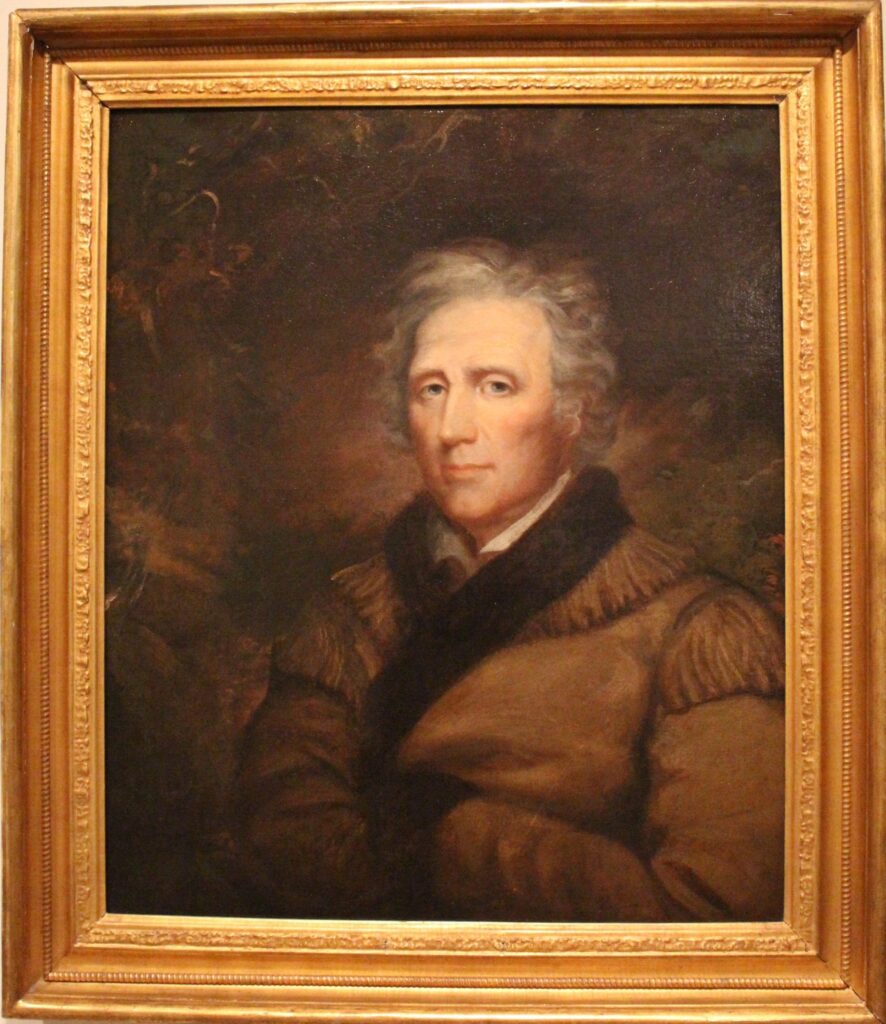
John James Audubon (attributed to)
Daniel Boone, circa 1810-1840
Oil on canvas
John James Audubon Museum Collection, JJA.1938.308
Current Location: Storage
This is an oil portrait of Daniel Boone attributed to John James Audubon. It depicts Boone from the chest up wearing buckskins and a black fur collar. He is facing to the left. Boone is shown in his later years with gray hair.
In the early 20th century, this portrait came to a New York portrait dealer, C.W. Lyon, from the descendants of James K. Paulding, Sr. Paulding was a nature lover and close friend of John James Audubon. The painting was examined by Lyon, Russell W. Thorpe, and Albert W. Rosenthal, who all agreed with the Audubon attribution based on the technique and background color.
The State of Kentucky purchased the portrait from C.W. Lyon on July 10, 1938.
John James Audubon (attributed to)
Jacob Bugg Hopkins, circa 1819
Oil on canvas
Rhoda B. Tanner Doubleday Collection, JJA.1953.13
Current Location: Storage
John James Audubon (attributed to)
Caroline Brent Hopkins, circa 1819
Oil on canvas
Rhoda B. Tanner Doubleday Collection, JJA.1953.14
Current Location: Storage
These portraits of Jacob Bugg Hopkins and Caroline Brent Hopkins may have been painted by John James Audubon. Hopkins was the son of General Samuel Hopkins and Elizabeth Branch Bugg (daughter of Jacob Bugg). He was born in February 1790 in Henderson County, Kentucky, and died in 1848 in Kentucky. Caroline Brent Hopkins was born in February 1794 in Richmond, Virginia, and died in August 1829. The portraits of Hopkins and his wife, Caroline, hung in the Spring Garden plantation in Henderson, Kentucky. Union soldiers are said to have damaged the portraits when the plantation was occupied as an army headquarters during the Civil War.
The portrait of Hopkins depicts a man in his late 20s or early 30s. Clean-shaven, he has brown hair and brown eyes. Hopkins wears a black jacket, white shirt, and cravat. The canvas has crease marks as though it had been folded at one time. Stamped on the back of the canvas in black are the words, “Jacob Bugg Hopkins / B. Feb. 1790 / D. […] 1848.”
The portrait of Caroline Brent Hopkins shows a woman in her 20s or early 30s. Her eyes are a brownish-gray and she has rosy cheeks and pink lips. Her light brown hair is arranged in an elaborate up-do style. She wears a burgundy dress with a white lace collar tied into a knot, a black necklace with an orange bead, and gold earrings with orange stones. Her left arm is depicted upright with a bible in her hand. There are crease marks in the canvas as though it had been folded at one time. An inscription is printed on the lower left corner of the painting, reading, “Restored by / Lida Williams / 1927.”
In 2000, the Portland Museum in Louisville, Kentucky, received a gift of two portraits that came with the story that they had been painted by John James Audubon. These portraits were very similar in size, technique, and character to the Audubon Museum’s portraits of Jacob Bugg Hopkins and Caroline Hopkins. The curator of our museum at the time took both the Hopkins portraits and the portraits of Audubon’s sons to the Speed Art Museum in Louisville. There, art conservator Robert Lodge of the Oberlin Art Institute examined our four portraits, the portraits from the Portland Museum, and portraits owned by the Speed Art Museum. His conclusion was that all the paintings had been done by the same artist at different periods, but declined to claim that all had been done by Audubon.
We believe that the Hopkins portraits could very well be early oil-on-canvas attempts by Audubon based on several factors:
- Their local history;
- The subjects were known by Audubon during his time in Henderson;
- The paintings were completed while Audubon was living in Henderson;
- The portraits are oil on canvas, a medium that Audubon did not feel comfortable with.
We have not been able to verify this claim yet, but we hope that the Hopkins portraits can be studied in the future as new techniques and knowledge arise.
Gift of Rhoda B. Tanner Doubleday, 1953.
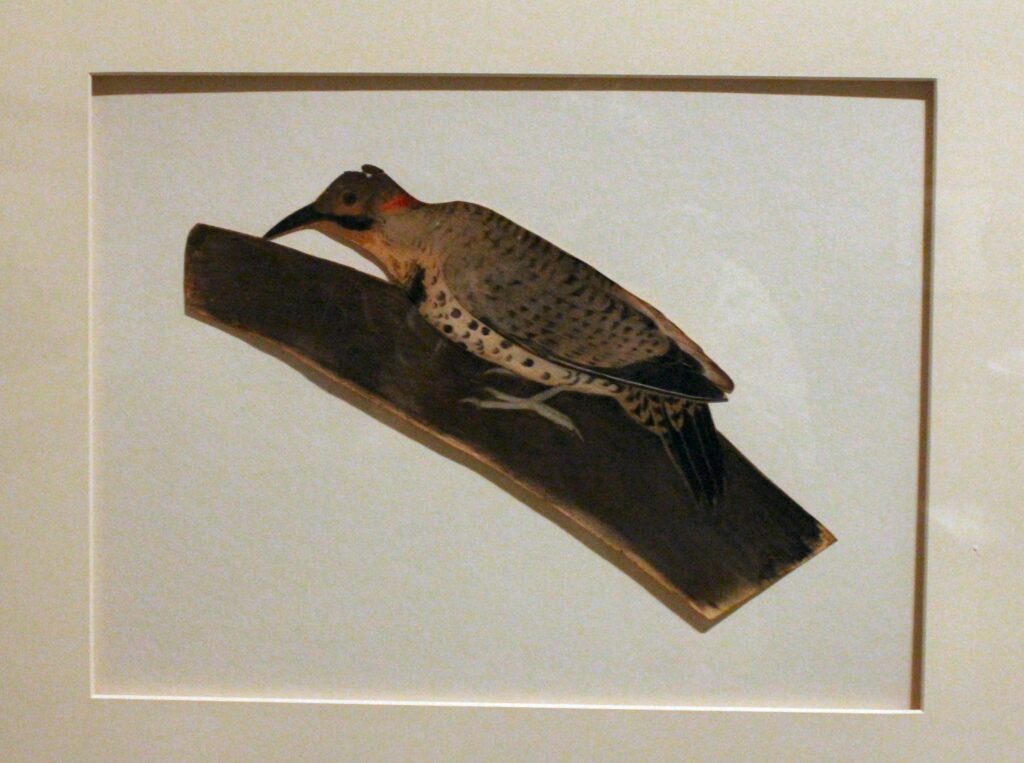
John James Audubon
Golden-winged Woodpecker, circa 1819
Watercolor, pastel, crayon
Henderson County Historical Society Collection, JJA.1938.141
Current Location: Storage
This is an original watercolor and crayon of a golden-winged woodpecker, or flicker. The image was cut out and pasted to a paper backing. It shows a single male flicker with brown feathers and black spots perched on a tree branch.
The drawing was owned by Judge Thomas Towles and was given to Alexander Towles on September, 28, 1913 by his mother, Bettie Towles Barret, daughter of Judge Towles. It was later given to the Henderson County Historical Society by Alex B. Barret. The Henderson County Historical Society donated the drawing to the Audubon Museum in 1938.
Gift of the Henderson County Historical Society, 1938.

